DDR does not exist as an objective fact
A lot of talk about the name (not important), little on the underlying phenonom (very important). Over here Pano is working on a method to measure it: http://www.diyaudio.com/forums/everything-else/273330-low-level-detail-experimental-search-test.html
dave
Hi,
There is no single underlying phenomenon to be understood.
The claimed phenomena could have several myriad reasons.
In fact your best bet in rating drivers is the ability of an FR
to ascertain the difference between various different file
types in consistent double blind listening tests.
There is no point to DDR if its not in the test file.
rgds, sreten.
There is no single underlying phenomenon to be understood.
The claimed phenomena could have several myriad reasons.
In fact your best bet in rating drivers is the ability of an FR
to ascertain the difference between various different file
types in consistent double blind listening tests.
There is no point to DDR if its not in the test file.
rgds, sreten.
This thread seems to be setting out a methodology where a driver in its raw state is compared to the same driver with equalisation applied and showing that the two sound different. Not sure what surprise there is there.
This thread seems to be setting out a methodology where a driver in its raw state is compared to the same driver with equalisation applied and showing that the two sound different. Not sure what surprise there is there.
Hi,
The implication is you perceive more detail for unequalised.
And that detail might be comprehended as DDR.
An argument going nowhere IMO.
rgds, sreten.
Clip A has far more detail and clip A-B starts too with more details until 21-22 seconds down the track it gets less detailed. From own experience listening different drivers and their responses lead me to clip A is raw driver response and clip B is the EQed one.So has anyone been able to hear more micro detail in one of the clips vs the other? Or in the AB clip whether more detail is first or last?
Thanks sharing study including all the work put into it.
Thanks for your feedback on the sound clips Byrtt. I will post the answer key tomorrow to give people a little more time to listen and judge for themselves.
same for me.
A - far more detailed not just in tweeter range but midrange / voices has more space around. HF are also brightest
a-b - starting quite detailed but midrange doesnt have same clarity as clip a and HF are a lot calmer
B - sounds like the flatest response but with midrange blured.
alpairs got something for sure its not just HF zone and peaks above 12k ... its like higher resolution on latest TV ... you can come nearly with your face to 4k tv and see every detailed without distortion and shaped corectly no pixels...
you still can see overal good quality on normal tv even HD, its not about being sharper with better contrasts or higher saturation, but information you can see.
Same apply to sound.
see a measurements of w8 1808
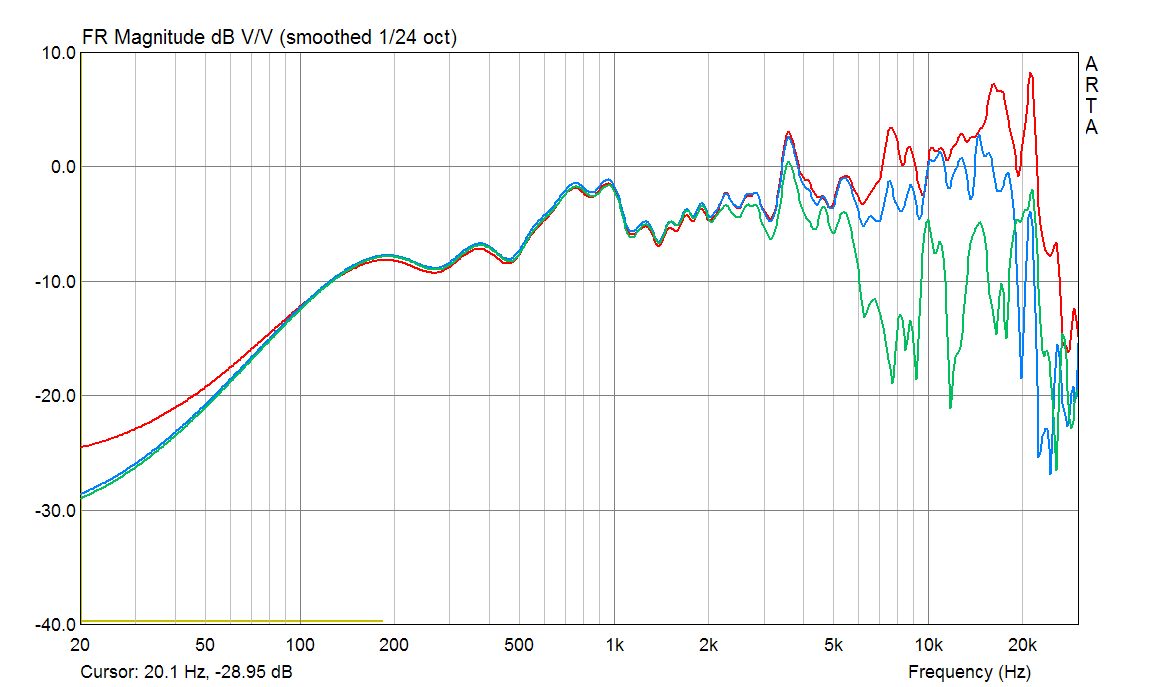
it has even bigger rising response and it is brighter but not as detailed as alpair.
Saying that im not saying as alpair is perfect as the dip between 1-2k is very bad to my ears ... speaker has more details in it but as well some freqs are sucked out...
again comparing to w8 1808 is not shouty at all more laid back.
A - far more detailed not just in tweeter range but midrange / voices has more space around. HF are also brightest
a-b - starting quite detailed but midrange doesnt have same clarity as clip a and HF are a lot calmer
B - sounds like the flatest response but with midrange blured.
alpairs got something for sure its not just HF zone and peaks above 12k ... its like higher resolution on latest TV ... you can come nearly with your face to 4k tv and see every detailed without distortion and shaped corectly no pixels...
you still can see overal good quality on normal tv even HD, its not about being sharper with better contrasts or higher saturation, but information you can see.
Same apply to sound.
see a measurements of w8 1808

it has even bigger rising response and it is brighter but not as detailed as alpair.
Saying that im not saying as alpair is perfect as the dip between 1-2k is very bad to my ears ... speaker has more details in it but as well some freqs are sucked out...
again comparing to w8 1808 is not shouty at all more laid back.
its just my personal opinion,
but it must be said that referring to the quality of those recordings doesnt mean much as its again like trying to find the finest details on 4k tv using binoculars from 500m. IMO pointless.
but it must be said that referring to the quality of those recordings doesnt mean much as its again like trying to find the finest details on 4k tv using binoculars from 500m. IMO pointless.
its just my personal opinion,
but it must be said that referring to the quality of those recordings doesnt mean much as its again like trying to find the finest details on 4k tv using binoculars from 500m. IMO pointless.
Not sure why you say pointless because that contradicts your previous post where you say the recordings clearly have more detail in A than in B, and in the A-B clip there is more detail in first half. If the recordings, no matter how limited by the MP3 compression and electronics signal train, manage to convey this conclusively to your ears, I think they achieved their objective.
Both you and Byrtt have confirmed that the unequalized A7.3 has more apparent detail.
Looking at the Alpair's FR graphs gives you the answer to that, yes?
The answer to why a driver has RESA? Yes - that is what I posited in post 1. The frequency response that has unusually high peaks in the high mids to high treble will have the perceived sense of more detail. Whether or not this detail is something one likes to hear is really personal preference.
So, interpretations of "objective" measurements aside, you're saying there's room for tolerance of subjective evaluation / personal preference, provided one doesn't get didactic in the sharing of same?
So, interpretations of "objective" measurements aside, you're saying there's room for tolerance of subjective evaluation / personal preference, provided one doesn't get didactic in the sharing of same?
Not sure what you are asking, but have I ever said that one can't like what one likes? What I want to be understood is that different drivers have different levels of detail enhancement. And that the various levels of enhancement are exactly that - so that doesn't make a driver that has a neutral flat frequency response as inherently "lifeless". If one likes lots of RESA - that is fine. Just realize it is not present at those levels in the source as intended by the mix engineer.
.....alpairs got something for sure its not just HF zone and peaks above 12k ... its like higher resolution on latest TV ... you can come nearly with your face to 4k tv and see every detailed without distortion and shaped corectly no pixels.....
.....Saying that im not saying as alpair is perfect as the dip between 1-2k is very bad to my ears ... speaker has more details in it but as well some freqs are sucked out.....
Before we declare or claim a driver having more resolution as said above think the two sound clips show some tendency and the EQed one is only being corrected at the two peaks highest in frequency area, guess if you correct it fully flat in all audio band the details are gone and we then back to the old TV spec resolution (detail) 🙂.
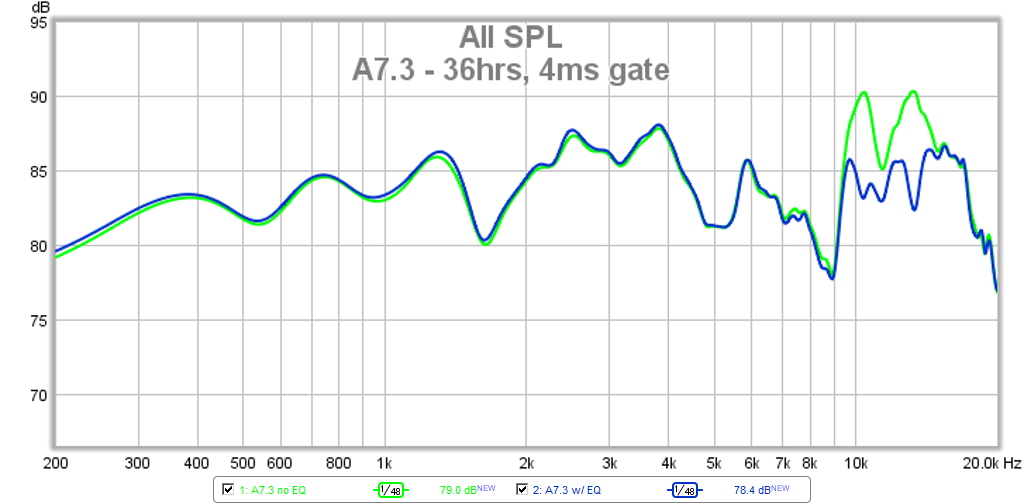
Own experience listening A7.3m out of box meaning no EQ or DSP at all is it doesn't sound as most but is very pleasing and entertaining good value and has nice more low end extension than most inside 3" class full rangers, in this raw config it adds details that is not there if listening in headphones or other reference speakers.
The relative high Q frequency response energy peaks and dips as seen above seems have some serious influence for some the extra perceived details this driver perform without EQ or DSP correction.
Last edited:
No, I was answering this.The answer to why a driver has RESA?
Both you and Byrtt have confirmed that the unequalized A7.3 has more apparent detail.
its all fair to please one's tastes music and equipment-wise. Besides, SE purist amps, oil caps, etc., I've enjoyed common cheap "exciters" with solid state setups and know they can fake "detail" at a lower cost than some touted to be audiophile toys.
Most folks call that "noise floor."DDR is the lower limit of the dynamic range under dynamic conditions.
dave
these arguments are a variation of the golden ear syndrome! in the end, he who uses DDR will claim a certain wisdom has given them the ability to judge the 'goodness' of a FR driver over all measurement based tools. e.g. Dismiss any /all science of measurements. FUD for their expertise.
What the sound clip sounds like through a "flat" system
I just built and tested my reference 2-way FAST monitor using the Scanspeak 10F/8424 and RS225-8. Here is the measured response (2dB/div) and here is the link to what this soundclip should sound like as played from a flat response speaker with very little coloration.
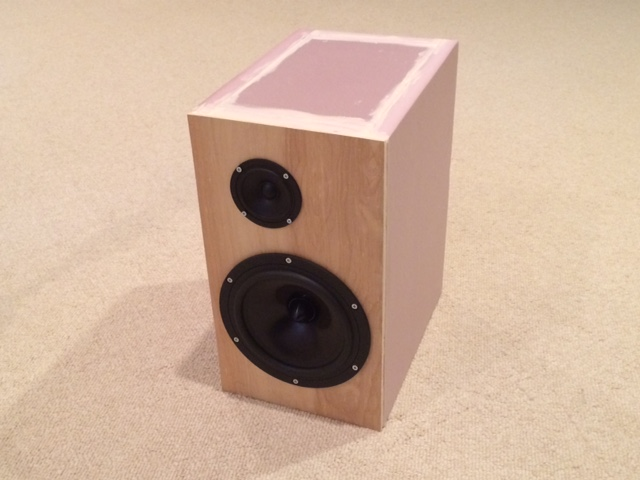
Freq Response (those wiggles look big because this is 2dB/div):
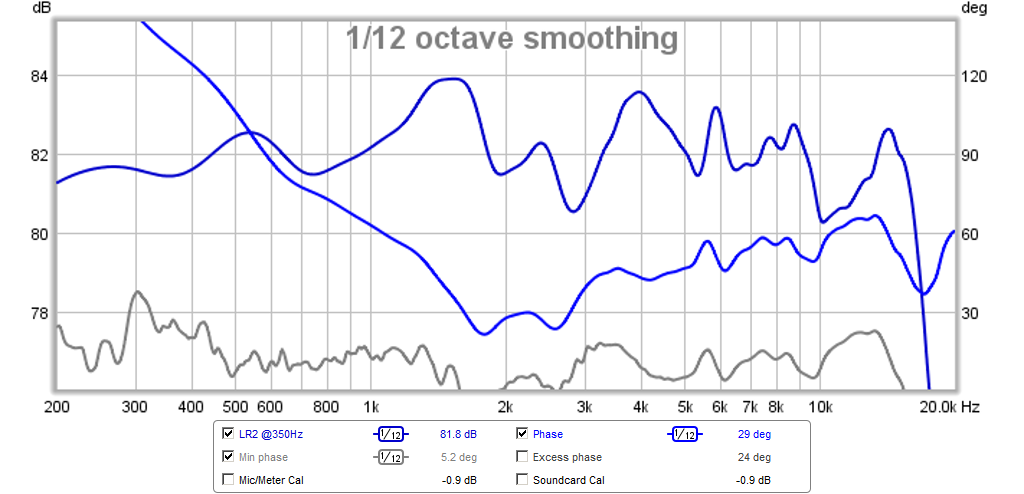
Here is the harmonic distortion:
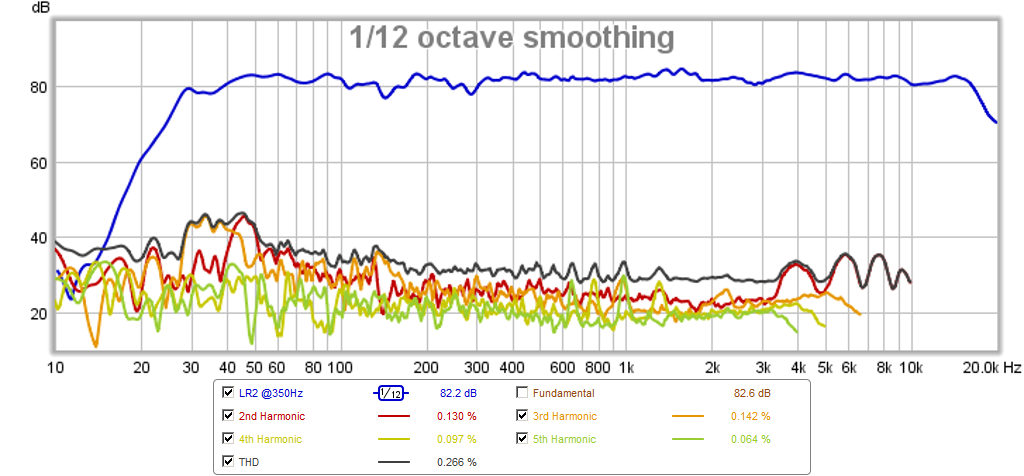
Sound Clip:
http://www.diyaudio.com/forums/attachments/full-range/479810d1430135110-10f-8424-rs225-8-fast-ref-monitor-10f-8424-rs225-8-fast-clip-c.asc
I just built and tested my reference 2-way FAST monitor using the Scanspeak 10F/8424 and RS225-8. Here is the measured response (2dB/div) and here is the link to what this soundclip should sound like as played from a flat response speaker with very little coloration.

Freq Response (those wiggles look big because this is 2dB/div):

Here is the harmonic distortion:

Sound Clip:
http://www.diyaudio.com/forums/attachments/full-range/479810d1430135110-10f-8424-rs225-8-fast-ref-monitor-10f-8424-rs225-8-fast-clip-c.asc
..isn't better to call it UDR, (upward dynamic range) with all the peaks in response;o) Sure sounds exciting at the beginning but gets tiring in the long run.
BTW, isn't MLSSA measurement supposed to show the ringing/resonating of drivers. Less ringing, less noise downwards when supposed to be a "quiet" moment of driver?
Anyway, been a happy owner of Genelec's for 15 years, have been building quite a lot speakers praised by various people and bought some commercial variations. However, my 1030A is coming back to duty sooner or later. (55Hz-18kHz +-2.5db) Never disappointing but sound a bit dull at first, nevertheless, one can sit and listen forevereandever……….
It's "awright" to like a sound but not to give it EOM (extra ordinary magic) of unchartered territory without backing it up.
Peter
BTW, isn't MLSSA measurement supposed to show the ringing/resonating of drivers. Less ringing, less noise downwards when supposed to be a "quiet" moment of driver?
Anyway, been a happy owner of Genelec's for 15 years, have been building quite a lot speakers praised by various people and bought some commercial variations. However, my 1030A is coming back to duty sooner or later. (55Hz-18kHz +-2.5db) Never disappointing but sound a bit dull at first, nevertheless, one can sit and listen forevereandever……….
It's "awright" to like a sound but not to give it EOM (extra ordinary magic) of unchartered territory without backing it up.
Peter
- Status
- Not open for further replies.
- Home
- Loudspeakers
- Full Range
- Resonance Enhanced Selective Amplification (RESA) - aka DDR